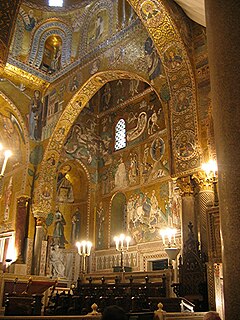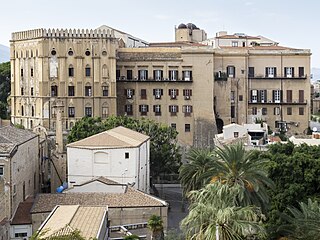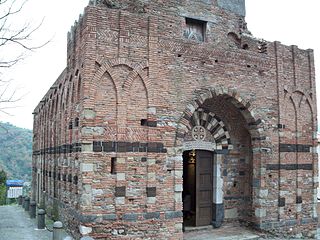 W
WThe term Norman–Arab–Byzantine culture, Norman-Sicilian culture or, less inclusively, Norman–Arab culture, refers to the interaction of the Norman, Latin, Arab and Byzantine Greek cultures following the Norman conquest of Sicily and of Norman Africa from 1061 to around 1250. The civilization resulted from numerous exchanges in the cultural and scientific fields, based on the tolerance showed by the Normans towards the Greek-speaking populations and the Muslim settlers. As a result, Sicily under the Normans became a crossroad for the interaction between the Norman and Latin Catholic, Byzantine–Orthodox and Arab–Islamic cultures.
 W
WArab-Norman Palermo and the Cathedral Churches of Cefalù and Monreale is a series of nine religious and civic structures located on the northern coast of Sicily dating from the era of the Norman Kingdom of Sicily (1130-1194): two palaces, three churches, a cathedral, and a bridge in Palermo, as well as the cathedrals of Cefalù and Monreale. They have been designated together as a UNESCO World Heritage Site. This dedication took place in 2015.
 W
WCaltanissetta is a comune in the central interior of Sicily, Italy, and the capital of the Province of Caltanissetta. Its inhabitants are called Nisseni.
 W
WThe Palatine Chapel is the royal chapel of the Norman Palace in Palermo, Sicily. This building is a mixture of Byzantine, Norman and Fatimid architectural styles, showing the tricultural state of Sicily during the 12th century after Roger I and Robert Guiscard conquered the island.
 W
WThe Castello di Caccamo is a castle in Caccamo, Sicily. It is among the largest and best preserved Norman castles in Sicily, and one of the largest in Italy.
 W
WThe Castello Maniace is a citadel and castle in Syracuse, Sicily, southern Italy. It is situated at the far point of the Ortygia island promontory, where it was constructed between 1232 and 1240 by the Emperor Frederick II. It bears the name of George Maniakes, the Byzantine general who besieged and took the city in 1038. Originally, one could only enter the castle over a bridge spanning a moat. A feature of the castle is the decorated portal. Today the castle is open to public and is a local tourist attraction in Syracuse.
 W
WThe Castello Normanno, or alternatively the Castello di Aci, is a castle in Aci Castello in the Metropolitan City of Catania in Sicily, southern Italy. The castle is situated on a rocky outcrop jutting out into the sea. Its precise date of construction is uncertain, but it was important to the development of its region during the Middle Ages. During the War of the Sicilian Vespers, it was subject to Roger of Lauria. It was besieged more than once, and was briefly controlled by the Spanish. It is currently a museum.
 W
WThe Castello normanno is a castle in Paternò, in the Province of Catania, Sicily, southern Italy.
 W
WThe Cathedral of Cefalù is a Roman Catholic basilica in Cefalù, Sicily. It is one of nine structures included in the UNESCO World Heritage Site known as Arab-Norman Palermo and the Cathedral Churches of Cefalù and Monreale.
 W
WThe Church of San Cataldo is a Catholic church located at Piazza Bellini in central Palermo, Sicily, Italy. Erected in 1154 as a notable example of the Arab-Norman architecture which flourished in Sicily under Norman rule on the island, the church is annexed to that of Santa Maria dell'Ammiraglio. Since the 1930s, it belongs to the Order of the Holy Sepulchre.
 W
WThe Church of St. Mary of the Admiral, also called Martorana, is the seat of the Parish of San Nicolò dei Greci, overlooking the Piazza Bellini in Palermo, Sicily, southern Italy.
 W
WThe Church of the Santissima Annunziata dei Catalani is a church in Messina, Sicily Italy. It is an example of Norman architecture in Sicily.
 W
WMonte Consolino is a mountain in the Serre Calabresi range, in the Vallata dello Stilaro of south-western Calabria, in southern Italy. Monte Consolino has an altitude of 701 metres (2,300 ft).
 W
WThe Cuba is a palace in the Sicilian city of Palermo. It was built in 1180 by William II of Sicily in his great Royal Park, as his personal recreation pavilion, together with an artificial lake: it shows strong Fatimid art influences, as it was designed and decorated by Arab artists still living in Palermo after the Norman conquest in 1072. During the rule of Bourbon kings of Naples it was annexed to a barracks. In the 16th century it was turned into a lepers' colony.
 W
WGaeta is a city and comune in the province of Latina, in Lazio, Southern Italy. Set on a promontory stretching towards the Gulf of Gaeta, it is 120 kilometres from Rome and 80 km (50 mi) from Naples.
 W
WMonreale is a town and comune in the Metropolitan City of Palermo, in Sicily, southern Italy. It is located on the slope of Monte Caputo, overlooking the very fertile valley called "La Conca d'oro", a production area of orange, olive and almond trees, the produce of which is exported in large quantities. The town, which has a population of approximately 39,000, is about 7 kilometres inland (south) of Palermo, the regional capital.
 W
WThe Palazzo dei Normanni or Royal Palace of Palermo is a palace in Palermo, Italy. It was the seat of the Kings of Sicily with the Hauteville dynasty and served afterwards as the main seat of power for the subsequent rulers of Sicily. Since 1946 it has been the seat of the Sicilian Regional Assembly. The building is the oldest royal residence in Europe; and was the private residence of the rulers of the Kingdom of Sicily and the imperial seat of Frederick II and Conrad IV.
 W
WSan Giovanni degli Eremiti is a church in Palermo, Sicily, near the Palazzo dei Normanni.
 W
WSanti Pietro e Paolo d’Agrò is a church in Casalvecchio Siculo, in the Metropolitan City of Messina on Sicily (Italy). It is one of the foremost examples on Sicily of Norman architecture.
 W
WThe Zisa is a castle in the western part of Palermo in Sicily, southern Italy. It is included in the UNESCO Arab-Norman Palermo and the Cathedral Churches of Cefalù and Monreale World Heritage Site.